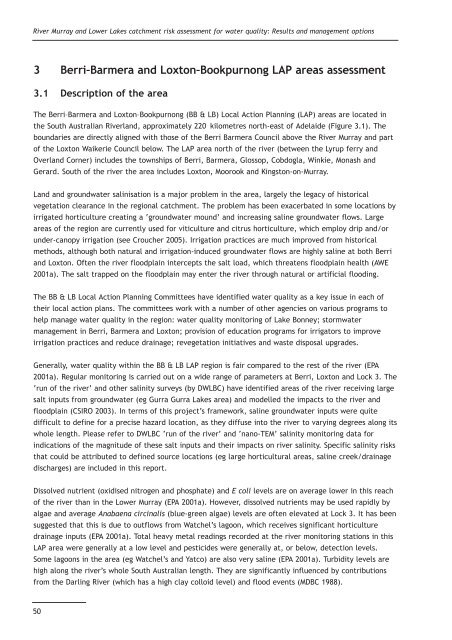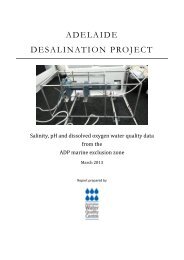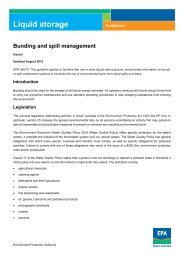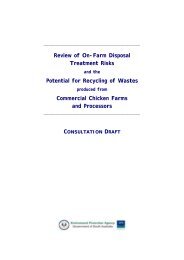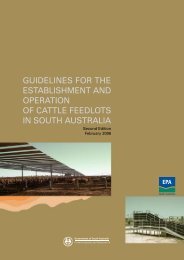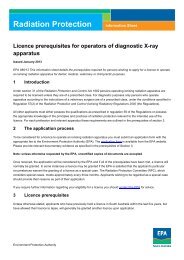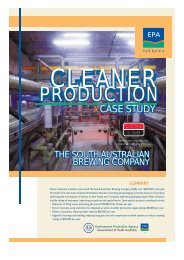2 Renmark to border LAP area assessment - EPA - Sa.gov.au
2 Renmark to border LAP area assessment - EPA - Sa.gov.au
2 Renmark to border LAP area assessment - EPA - Sa.gov.au
Create successful ePaper yourself
Turn your PDF publications into a flip-book with our unique Google optimized e-Paper software.
River Murray and Lower Lakes catchment risk <strong>assessment</strong> for water quality: Results and management options<br />
3 Berri–Barmera and Lox<strong>to</strong>n–Bookpurnong <strong>LAP</strong> <strong>area</strong>s <strong>assessment</strong><br />
3.1 Description of the <strong>area</strong><br />
The Berri–Barmera and Lox<strong>to</strong>n–Bookpurnong (BB & LB) Local Action Planning (<strong>LAP</strong>) <strong>area</strong>s are located in<br />
the South Australian Riverland, approximately 220 kilometres north-east of Adelaide (Figure 3.1). The<br />
boundaries are directly aligned with those of the Berri Barmera Council above the River Murray and part<br />
of the Lox<strong>to</strong>n Waikerie Council below. The <strong>LAP</strong> <strong>area</strong> north of the river (between the Lyrup ferry and<br />
Overland Corner) includes the <strong>to</strong>wnships of Berri, Barmera, Glossop, Cobdogla, Winkie, Monash and<br />
Gerard. South of the river the <strong>area</strong> includes Lox<strong>to</strong>n, Moorook and Kings<strong>to</strong>n-on-Murray.<br />
Land and groundwater salinisation is a major problem in the <strong>area</strong>, largely the legacy of his<strong>to</strong>rical<br />
vegetation clearance in the regional catchment. The problem has been exacerbated in some locations by<br />
irrigated horticulture creating a ‘groundwater mound’ and increasing saline groundwater flows. Large<br />
<strong>area</strong>s of the region are currently used for viticulture and citrus horticulture, which employ drip and/or<br />
under-canopy irrigation (see Croucher 2005). Irrigation practices are much improved from his<strong>to</strong>rical<br />
methods, although both natural and irrigation-induced groundwater flows are highly saline at both Berri<br />
and Lox<strong>to</strong>n. Often the river floodplain intercepts the salt load, which threatens floodplain health (AWE<br />
2001a). The salt trapped on the floodplain may enter the river through natural or artificial flooding.<br />
The BB & LB Local Action Planning Committees have identified water quality as a key issue in each of<br />
their local action plans. The committees work with a number of other agencies on various programs <strong>to</strong><br />
help manage water quality in the region: water quality moni<strong>to</strong>ring of Lake Bonney; s<strong>to</strong>rmwater<br />
management in Berri, Barmera and Lox<strong>to</strong>n; provision of education programs for irriga<strong>to</strong>rs <strong>to</strong> improve<br />
irrigation practices and reduce drainage; revegetation initiatives and waste disposal upgrades.<br />
Generally, water quality within the BB & LB <strong>LAP</strong> region is fair compared <strong>to</strong> the rest of the river (<strong>EPA</strong><br />
2001a). Regular moni<strong>to</strong>ring is carried out on a wide range of parameters at Berri, Lox<strong>to</strong>n and Lock 3. The<br />
‘run of the river’ and other salinity surveys (by DWLBC) have identified <strong>area</strong>s of the river receiving large<br />
salt inputs from groundwater (eg Gurra Gurra Lakes <strong>area</strong>) and modelled the impacts <strong>to</strong> the river and<br />
floodplain (CSIRO 2003). In terms of this project’s framework, saline groundwater inputs were quite<br />
difficult <strong>to</strong> define for a precise hazard location, as they diffuse in<strong>to</strong> the river <strong>to</strong> varying degrees along its<br />
whole length. Please refer <strong>to</strong> DWLBC ‘run of the river’ and ‘nano-TEM’ salinity moni<strong>to</strong>ring data for<br />
indications of the magnitude of these salt inputs and their impacts on river salinity. Specific salinity risks<br />
that could be attributed <strong>to</strong> defined source locations (eg large horticultural <strong>area</strong>s, saline creek/drainage<br />
discharges) are included in this report.<br />
Dissolved nutrient (oxidised nitrogen and phosphate) and E coli levels are on average lower in this reach<br />
of the river than in the Lower Murray (<strong>EPA</strong> 2001a). However, dissolved nutrients may be used rapidly by<br />
algae and average Anabaena circinalis (blue-green algae) levels are often elevated at Lock 3. It has been<br />
suggested that this is due <strong>to</strong> outflows from Watchel’s lagoon, which receives significant horticulture<br />
drainage inputs (<strong>EPA</strong> 2001a). Total heavy metal readings recorded at the river moni<strong>to</strong>ring stations in this<br />
<strong>LAP</strong> <strong>area</strong> were generally at a low level and pesticides were generally at, or below, detection levels.<br />
Some lagoons in the <strong>area</strong> (eg Watchel’s and Yatco) are also very saline (<strong>EPA</strong> 2001a). Turbidity levels are<br />
high along the river’s whole South Australian length. They are significantly influenced by contributions<br />
from the Darling River (which has a high clay colloid level) and flood events (MDBC 1988).<br />
50


